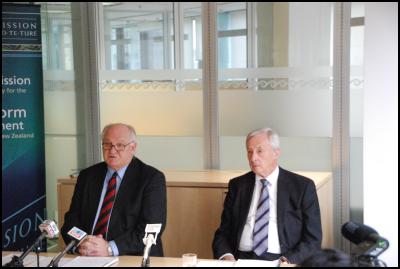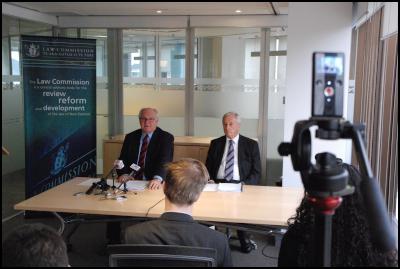"Better Digital Citizens" - Law Commission on Cyber Bullying
Press Conference on Combatting Harmful Digital Communication - 15th August, 2012
By Mark P. Williams

Today the Law Commission announced its draft of a report on what it calls 'harmful digital communication' or 'cyber bullying'. The report was announced by Hon. Sir Grant Hammond, and Professor John Burrows who outlined the rationale and recommendations of the report.
Sir Grant Hammond indicated that the report had been of interest to several ministers and departments including Minister of Justice Judith Collins, who had spoken to the Prime Minister to expedite the report. He added that coroners, the Police and the PPTA had all also indicated their interest in the report. Sir Hammond said that 1 in 10 respondents from a sample of 750 surveyed by the Law Commission said they had encountered "harmful speech" on the internet.
The report defines harmful digital communication as forms such as threats, harassment, dissemination of intimate personal visual recordings and incitement to suicide. It recommends a "four limbed" approach: the creation of a new criminal offence for "bad digital communication"; the amendment of existing statutes; the establishment of an authority to enable takedown and cease-and-desist orders; and some suggested changes to the legal regime for New Zealand schools.
Sir Hammond and Professor Burrows indicated that the central distinction made by the proposed new Tribunal would be "causing serious or substantial harm" via digital communication. The draft bill defines this as: A person using digital media for sending or causing to be sent, to another person, matter that is "grossly offensive", "of an indecent, obscene or menacing character" or "knowingly false" (Amendment to Section 21 of the Summary Offences Act 1981).
The amendment (Section 21A) gives the evidential requirement for prosecution as intent to cause "substantial emotional distress"; or that the sender, Person A "knew that the message or other matter would cause Person B substantial emotional distress"; or the message is such that "would cause emotional distress to someone in Person B's position" and "Person B in fact saw the message or other matter in any electronic media". It adds that "It is not necessary for the prosecution to establish that the message or other matter was directed specifically at person B".
Sir Hammond and Professor Burrows acknowledged that while there may be some question of subjectivity in determining the absolute limits of what is "grossly offensive" in most instances it would be clear whether the message was intended to and likely to cause genuine harm. The specific amendment says that several factors are to be taken into account when determining whether a message is to be considered "grossly offensive", these are listed as:
(a) the extremity of the language used:
(b) the age and characteristics of the victim:
(c) whether the message or other matter was anonymous:
(d) whether the message or other matter was repeated:
(e) the extent of circulation of the message or other matter:
(f) whether the message or other matter is true or false:
(g) the context in which the message or other matter appeared.
Both Professor Burrows and Sir Hammond emphasised that the primary intent of the report was to establish a protective framework to bring the law up to date with the existence of social media, and that it was largely a question of minor adaptation of existing legislation such as the Privacy Act and the Harassment Act to cope with digital forms.
Schools and the protection of children against abusive online behaviour are the major concern of the report. Professor Burrows suggested the development of "IT contracts" between pupils and their schools agreeing to specific ethical codes which could be enforced by the school.
Sir Hammond and Professor Burrows were questioned on the scope and threshold on what would constitute an offense. They responded that they saw it in terms of preventing the dissemination of materials that would cause "real harm" by violating the rights of the person. Asked whether New Zealand was lagging behind the times with these measures, Professor Burrows said that the UK has had a similar set of measures for twenty years.
They said that at heart the legislation was intended to help encourage everyone, from school age upwards, to become better digital citizens.
Click a link to play audio (or right-click to
download) in either
MP3 format or in OGG format.

Left Sir Grant Hammond;
Right, Professor John Burrows


Click for big version.
ENDS



 Keith Rankin: Dodgy Democracy, The Fiscal Double Standard, And The Application Of The Domino Theory To Ukraine
Keith Rankin: Dodgy Democracy, The Fiscal Double Standard, And The Application Of The Domino Theory To Ukraine Gordon Campbell: On Why GP Practices Are In Crisis
Gordon Campbell: On Why GP Practices Are In Crisis Ramzy Baroud: From Gaza To Syria - The Unyielding Reality Of Israeli Settler Colonialism
Ramzy Baroud: From Gaza To Syria - The Unyielding Reality Of Israeli Settler Colonialism Martin LeFevre - Meditations: The Polycrisis, Knowledge, And AI
Martin LeFevre - Meditations: The Polycrisis, Knowledge, And AI Ian Powell: Getting Out Of The Current Health System Mess
Ian Powell: Getting Out Of The Current Health System Mess Binoy Kampmark: More Guns, Less Butter - Starmer’s Defence Spending Splash
Binoy Kampmark: More Guns, Less Butter - Starmer’s Defence Spending Splash